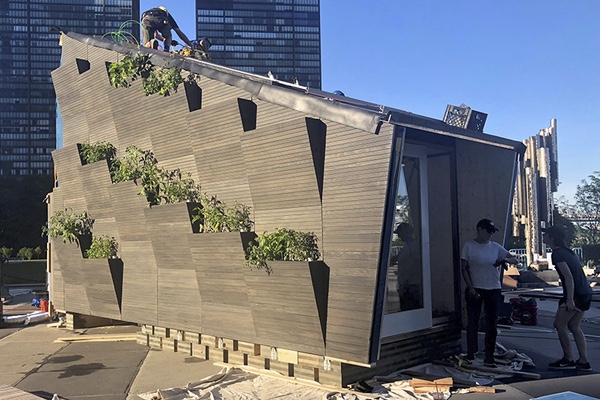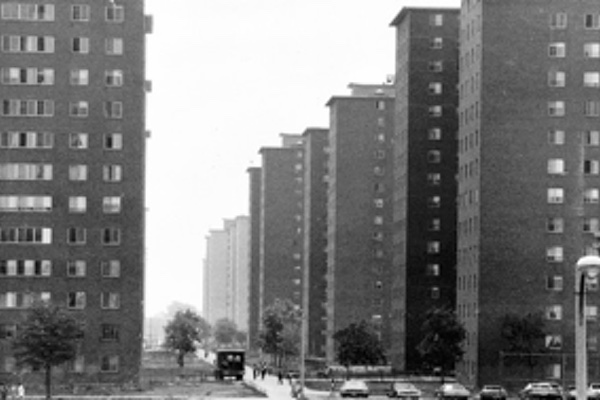Affordable Housing that Environmentalists Can Rave About

The first demonstration unit of the 22-square-meter “tiny house” on view in the UN Plaza in New York City (summer 2018).
The recent summer unveiling of a new eco-housing module at the UN, appropriately named the Ecological Living Module, has coincided with waning housing affordability and the broadest housing market slowdown in the past decade. Inventory in normally cutthroat markets is sitting stale for months. Almost 40 million American households are cost-burdened, spending more than 30% of their income on housing. There are on average only 35 affordable and available housing units for every 100 low-income households. The housing sector, worldwide, is using 40% of the planet’s total resources. Housing is facing an affordability and sustainability crisis.
The problem is that an affordable and eco-friendly 236 square foot tiny house (like the Ecological Living Module) seems incongruous with the most common form of affordable urban housing: public high-rises. Most do not have the Ecological Living Module’s built-in solar energy capabilities, plant-based air purification, or other sustainable systems in place. Instead, they have contributed to harsh psychological and economic effects on residents, including poor conditions and over-occupancy. Developing smarter, affordable and eco-friendly housing seems like a no-brainer. But when sustainability was applied to housing in the 1950s, it failed, and resulted in segregated housing. A new approach to housing sustainability can help public housing become affordable and eco-friendly while also reshaping our urban spaces.
In the mid-1900s calls for sustainable housing were instrumental in the justification of urban redevelopment initiatives and the construction of public housing across the United States. In many cities, including San Francisco, Chicago, and New York, neighborhoods with poor, deteriorating housing and older, tenement apartments underwent large urban renewal programs between the 1940s and 1970s. For a building to be condemned in Pennsylvania, for example, it had to be classified as a blighted area. Blighted areas were unsafe, unsanitary, and overcrowded with inadequate planning, inefficient land usage, and defective design. President Eisenhower outlined the goals of urban renewal to Congress in 1954, seeking to form healthy neighborhoods by redrawing streets, removing unsalvageable districts, and reorganizing traffic. Most of these sustainability-inspired programs had far from ideal results.

“Robert Taylor Homes”
TheChicago Housing Authority(CHA), for instance, proposed a multiple-year $317 million dollar initiativeto clear the city’s crumbling slums and build affordable housing in the 1950s. Ultimately, its programs only renewed the city’s segregation and poverty levels. While many CHA buildings had achieved balanced demographics before the mid-1950s, the percentage of the CHA’s minority tenants grew dramatically from under 60% to nearly 90% between 1955 and 1959. Similarly in Pittsburgh, approximately three homes were torn down for every one home replaced through the city’s urban renewal programs. These measures reduced housing stock for the poor while concentrating families into fewer and geographically smaller areas. Across the United States, black families were on average three times more likely to be relocated, and were often expected to pay double for similar homes. They were clustered together in large high-rise buildings like Chicago’s South Side “Wall.” Ambitious sustainability goals had become buzzwords to support public housing and, in turn, segregation.
Ironically, the very buildings and high-rises that were constructed on the premises of sustainability are now fueling calls to re-examine our nation’s public housing. The Robert Taylor Homes in Chicago, with 28 identical sixteen-story buildings containing 4,400 units and home to 27,000 residents, were only one such high-rise in a mass-produced, segregated, urban utopia. Segregation is a societal concern, but an environmental concern as well. Think about the stress on transportation systems and the surge in tailpipe emissions during rush-hour traffic when hundreds of thousands of people commute into and out of cities and neighborhoods they cannot afford to live in. Or the inefficient heating and cooling systems that are continuously leaking energy and wasting electricity. Or the wasteful procedures and hazardous materials used in construction. Globally, the housing sector contributes to nearly one-third of greenhouse gas emissions.
What if nurses and administrators could live near hospitals and office buildings and not spend two hours driving each way? We need to erode sprawl and incorporate affordable housing into buildings and developments throughout cities: near busy areas, near public transport, near offices, and near quiet parks. We need transit-oriented communities to reduce commutes. According to theNatural Resources Defense Council, including just five units of affordable housing in a brand-new, centrally-located 41-unit Los Angeles development can reduce vehicle distance travelled by over 22,000 miles and greenhouse gas emissions by nearly 29,000 pounds annually. That’s just one building, and it is already fostering racial and socioeconomic integration while helping save our planet.
What if teachers and firefighters could live in sustainably built, eco-friendly homes near their schools and fire stations? Urban areas need to adapt to our diversifying population and become desirable places to live, work, and play. And housing is a big part of the equation: sustainable urban housing enables living patterns that can reduce energy consumption, car dependence, carbon emissions, water pollutants, watershed diminishment and land disruption. We need meaningful incentives for green developers to support affordable housing. Green building materials and methods can reduce energy consumption by 33% and water use by 30%.
By considering housing and the environment separately, we’re failing to realize that action or inaction in one can have serious, often unintended consequences in the other. Housing is transportation, housing is energy, and housing is quality of life. If we continue treating sustainability as something that matters only to a select few and harboring a narrow definition of the environment, we miss out in identifying environmentally interconnected issues – like protecting and supporting affordable housing – at the cost of millions of people and the planet. We need to approach and address these issues together: the future of housing has to be at the crossroads of sustainability and affordability.